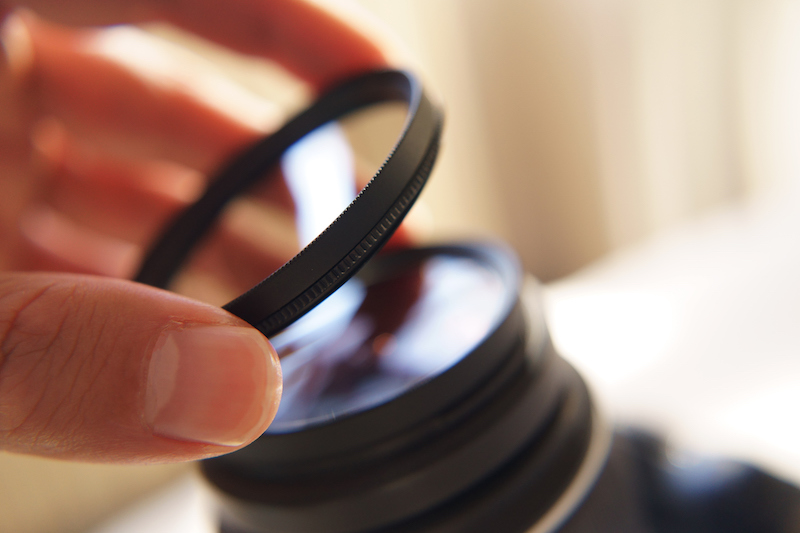
There are many different types of camera filters on the market. But what do they actually do? And – especially if you are new to photography – which are the best filters to start with?
In this article we explain what camera lens filters do, and introduce you to five types of filter that could be useful for you.
Camera lens filters are used to change the appearance of light in your camera. For example, they may reduce the amount of light or glare coming into your camera, or change the colours of your photo. Put simply, what camera lens filters do is to create photographic effects that wouldn’t otherwise be possible.
There are two different shapes of camera lens filters:
These screw directly onto the front of your lens. You will therefore either need to get a filter that exactly matches the diameter of your lens (this should be printed on the back of your lens camp), or you can get rings to screw onto your lens that will then enable you to attach a filter even if it is a different diameter.
Square or rectangular filters have an attachment system – usually a bracket and round ring – which screws onto the front of your lens. The filter can then be screwed onto the bracket. An advantage of this is that it makes it easier to combine different filters together by stacking them.
Let’s take a look at five of the best camera lens filters to get you started.
Unlike most other types of camera lens filter, UV filters are completely clear and make no actual difference to your photos. But many experts say that a UV filter is the first camera lens filter you should buy. So why is this the case?
The sole purpose of a UV filter is to protect your lens from dust, scratches or other damage. The UV filter will take the hit from all of those things and, even if it needs to be replaced at some stage, your actual lens will remain intact.
So UV filters are an excellent way to prolong the life of your lens and keep its glass in as good condition as possible.
Polarising filters are a great addition to your camera gear, and can be used in many ways for everyday photography. Light reflected from any flat surface can become polarised, which means that it increases in intensity and can cause glare and reduce visibility. The purpose of a polarising filter is to reduce the resultant glare in your photo. It can also manage the impact of reflection and glare from any kind of water or wet or shiny surface.
A polarising filter is also a useful tool for photographing activities involving people, such as social gatherings and sporting events. It will produce a more balanced exposure, and can help to create more vibrant colours in your shot and to reduce unwanted light and glare.
Think of a Neutral Density (ND) filter as sunglasses for your camera lens. An ND filter will slow down your shutter speed to reduce the light coming into your camera. This enables you to achieve long exposure effects, in which the camera’s shutter is left open for a period of time to be able to capture stationary images sharply whilst blurring any moving objects. This makes it a good filter to use both for landscape photography and for arty shots with moving objects.
A good ND filter to start with is a 10-stop filter, which are often called ND1000 filters. The ten different stops (light settings) on the filter enable you to capture long exposures in any kind of lighting or weather conditions.
As the name suggests, colour filters add colour to your photographs. But it’s not quite as straightforward as that. There are two types of colour filter, so let’s take a look at what they are and what they do:
This filter is simply a piece of coloured glass which is placed in front of the camera’s lens. A colour filter will change how the camera sees light, by filtering out some wavelengths of light and letting others through. As well as enhancing colours, a colour filter will also boost the contrast of the image.
Interestingly, colour filters are most commonly used for black and white photography, in order to control tone and contrast rather than colour. Different colours impact tone and contrast in different ways, and can create more depth for your black and white image.
Graduated colour filters either have different colours on different parts of the filter, or some colour just on part of the filter leaving the rest clear. For example, if you want to photograph a sunset sky, a graduated colour filter could be used to enhance the colour in the sky whilst leaving the foreground in its natural state. Another popular use of graduated colour filters is to add a sepia effect to part of your image.
If you are interested in very arty, otherworldly photography, an infrared filter could be the one for you. Infrared filters block out visible light and only allow infrared light to pass into the lens. This can produce a very creative result as the objects in your image will reflect infrared light very differently from normal light. The impact of infrared light will also be affected by the lighting conditions in which you are taking your shots.
We hope that this guide has helped you to understand more about what camera lens filters do and that you are in a better position to decide which filter(s) you need for the photos you want to take.
Check back here soon for more helpful photography guides from Print Your Memory.

Copyright 2025 © Print Your Memory. All rights Reserved.